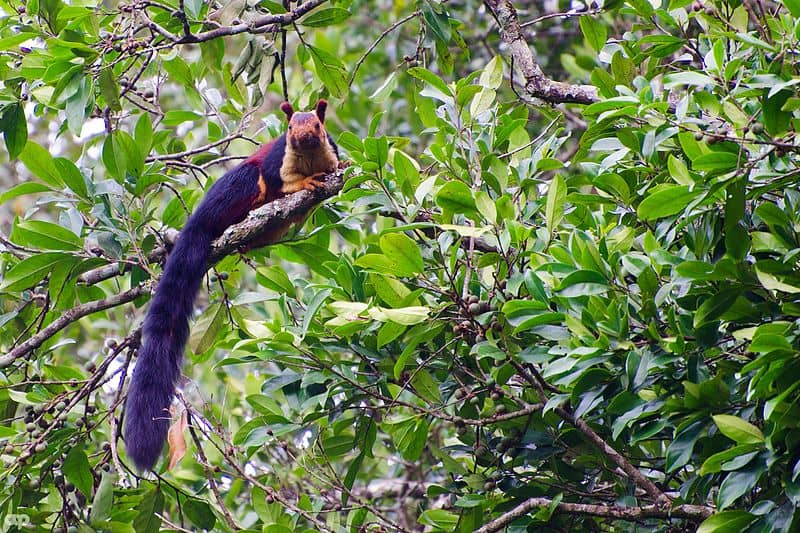
Indian Giant Squirrel Facts
- Clearly, the Indian Giant Squirrel obviously represents an extremely large variety of tree squirrel. It also sometimes goes by the alternate common name of the Malabar Giant Squirrel. Its scientific name, though, remains the hard to pronounce Ratufa indica.
- This magnificent creature owes its technical name to the German naturalist, Johann Christian Polycarp Erxleben. That’s due to the fact that he made the first formal recognition of it as a separate and distinct species. This he did in the year 1777.
- Scientists also presently acknowledge four different subspecies of the mammal. Amazingly, all of these exist on the same continent as the primary species. Though not unknown, such close association among species and subspecies remains uncommon.
- It also boasts a status that not many species can make. Within its endemic range, the animal appears to exist in fairly large numbers. Due to this pleasantly surprising fact, the IUCN currently lists the stunning animal as a Species of Least Concern.
- Unlike most related species, this stunning creature actually evolved as quite vocal. This represents yet another manner in which the Indian Giant Squirrel distinguishes itself. It also produces different sounds for such things as warnings, mating, and territorial calls.
Related Articles
Indian Giant Squirrel Physical Description
The Indian Giant Squirrel impresses the viewer due to more than just its incredible appearance. That’s because it also qualifies as a true giant of its kind. Somewhat surprisingly, though, it displays no noticeable degree of the physiological trait of sexual dimorphism.
Mature adults of both genders therefore attain the same general size. That’s an average body length of about 14 in (35.5 cm). The tail then adds another 24 in (61 cm). Despite its size, it does not attain a great weight. Mature adults also typically average about 4.4 lb (2 kg).
Its size alone does not make this impressive species stand out to observers. It generally presents a stunning pattern of natural coloring. This holds true due to the amazing fact that it generally presents a two-toned, and sometimes even a three-toned, color pattern.
The amazing coloring of the Indian Giant Squirrel does not stop there. Its exact pattern and combinations of colors also varies between individuals. These, though, most commonly consist of shades of tan, buff, rust, brown, and even, on rare occasions, a creamy-beige.
- Kingdom: Animalia
- Phylum: Chordata
- Class: Mammalia
- Order: Rodentia
- Family: Sciuridae
- Genus: Ratufa
- Species: R. indica
Indian Giant Squirrel Distribution, Habitat, and Ecology
Most unfortunately, the almost kaleidoscopic Indian Giant Squirrel evolved as endemic to a comparatively limited section of the globe. More precisely, the fabulous rodent inhabits a specific portion of Asia. That’s the region now known as the country of India.
More specifically, this range consists of the peninsular part of the country. That range is restricted, though, only extending as far north as the Madhya Pradesh. There, however, the wonder of Nature thankfully evolved a highly helpful versatility in regards to its habitat.
That’s because the visually breathtaking animal actually thrives in several different habitat types within that area. Due to this, it appears in evergreen forests, deciduous forests, and mixed forests, as well. This adaptability also sets it apart from related species.
This marvel of evolution also spends the vast majority of its time in the upper canopy of its region. In point of fact, the living kaleidoscope rarely ever descends form this location. Instead, it moves from tree to tree with great leaps, that can be as much as 20 ft (6 m).
Some of the subspecies of the creature evolved as omnivorous in nature. The Indian Giant Squirrel itself, however, has a herbivorous diet. It mainly feeds on various nuts, flowers, fruit, and tree bark. In turn, it itself mainly falls prey to leopards and birds of prey.
Species Sharing Its Range
Check out our other articles on 5 Incredibly Wonderful Trees, Pingualuit Crater Lake, Socotra Bluet, Barndoor Skate, Blue-lipped sea krait, Vietnamese Mossy Frog, Crabeater Seal
